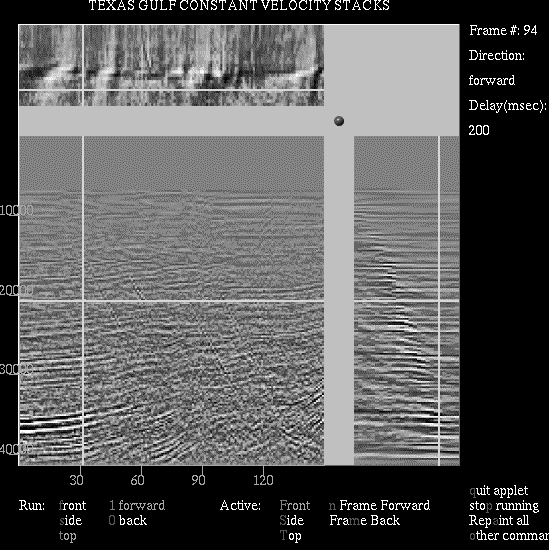




Next: CONCLUSIONS
Up: Lenga, Clapp, & Claerbout:
Previous: ANIMATOR
As more and more of SEP's research moves into the 3-D , 2-D viewers
are no longer sufficient. Often the researcher can gain new insight
by looking at orthogonal planes of the data simultaneously, and having the
ability to run through the 3-D cube along any of the three planes.
As a result SEP has developed
the in-house 3-D viewers, X11movie and Cubeplot, that provide this
extra level of sophistication. These programs have proven immensely useful,
but they:
cubejava
Figure 4 The Cube Viewer showing a portion
of wesvel. The cube shows the change in a section as a function of velocity.
If you have Java capabilities, click on the figure interact
button to go to the Cube Viewer.

- can not be run on the web without putting
considerable strain on the host
machine.
- suffer from
- a lack of interactivity in the case of Cubeplot
- difficult menu controls in the case of X11movie
The Cube Viewer solves these problems. The Cube Viewer
works along the same principle as the Animator.
It loads in a
SEPJava file
one frame of the cube at a time, creating the front image during
loading. Once the entire cube has been loaded, the side and top
images are created.
The display (Figure 4)
of the
Cube Viewer follows closely Cubeplot. The main
screen is broken
into three portions:
- Bottom left, the front view, constant i3 (slowest direction of the array).
- Bottom right, the side view, constant i2.
- Top left, the front view, constant i1 (fastest direction of the array).
On each displayed frame two yellow lines show the relative location of the other two
displayed planes.
The user can then use a series of key and mouse controls to navigate
through the cube. Appendix D provides a user's guide to the Cube Viewer.





Next: CONCLUSIONS
Up: Lenga, Clapp, & Claerbout:
Previous: ANIMATOR
Stanford Exploration Project
11/12/1997

